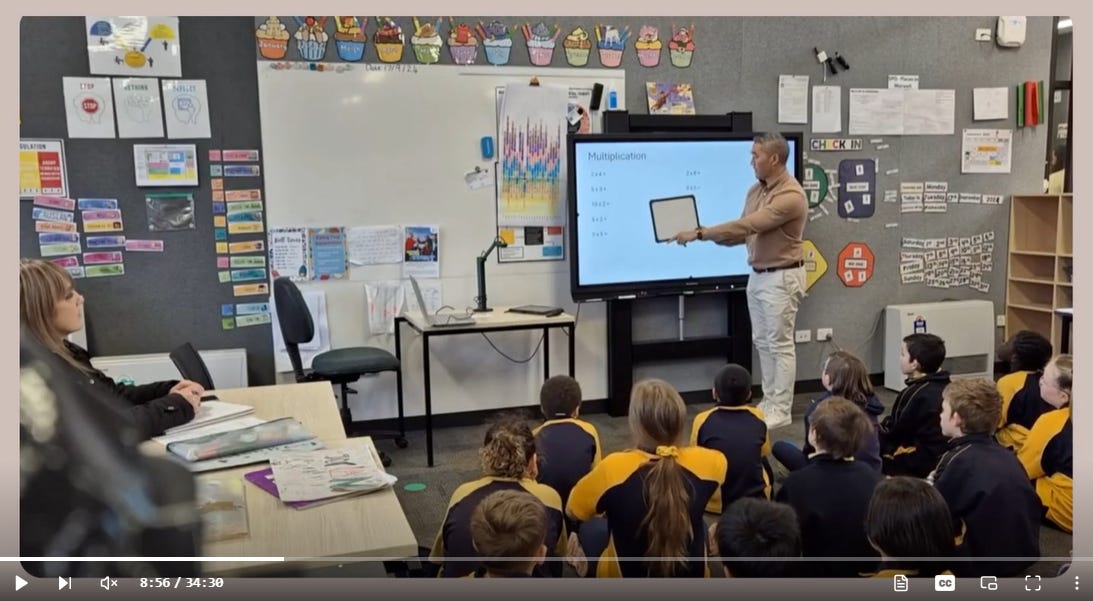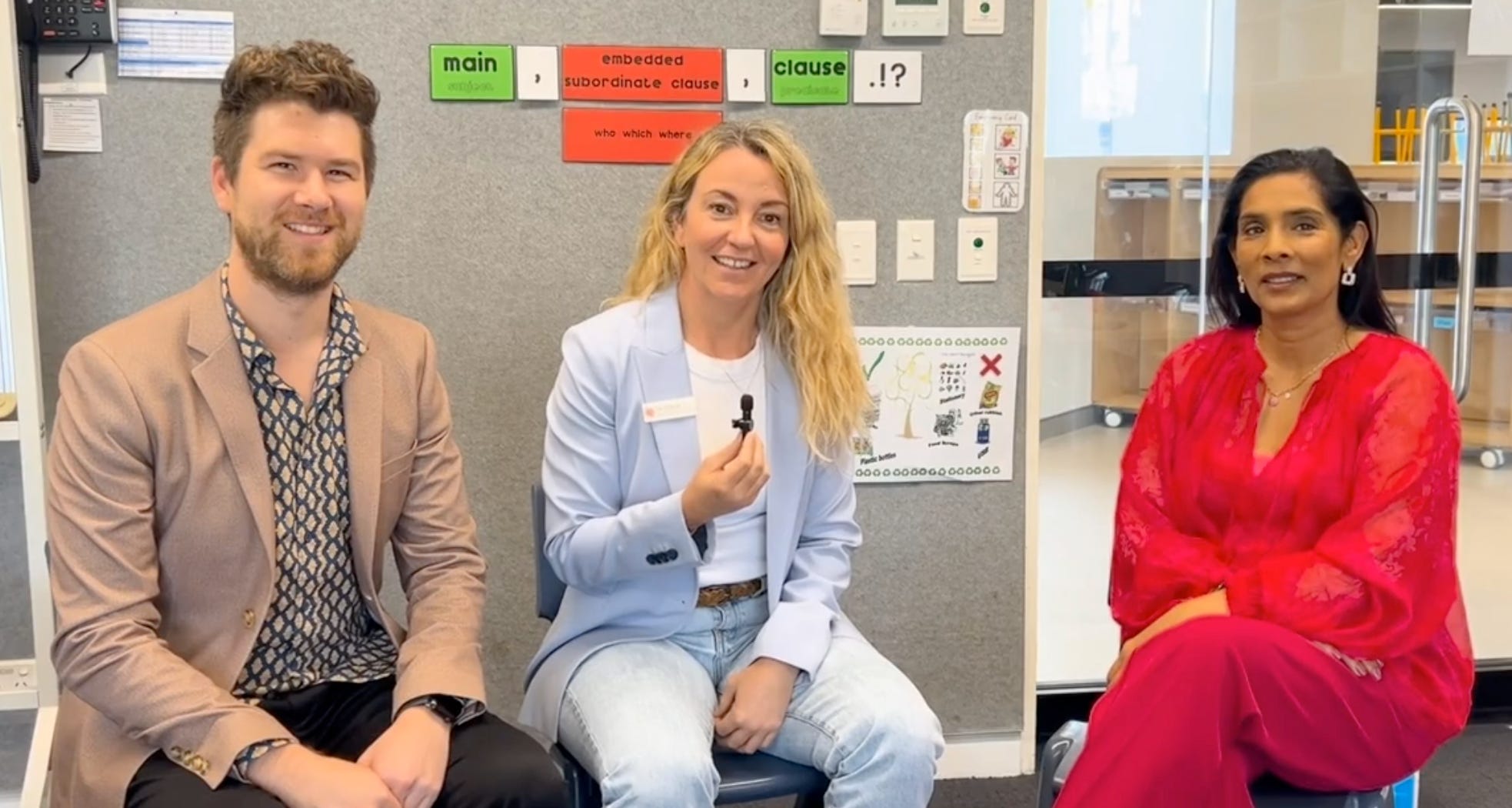Discover Chalk Dust
Chalk Dust

Chalk Dust
Author: Nathaniel Swain
Subscribed: 43Played: 220Subscribe
Share
© Nathaniel Swain
Description
Welcome to Chalk Dust, the podcast that gives you a front row seat into some of the best classrooms in the world. There are lots of great conversations about teaching and education happening around the world right now. There are already so many fantastic podcasts out there about evidence based practice, and we're so excited to bring you one more, but this one has a distinctive difference.
Each episode, Rebecca Birch and Nathaniel Swain break down real classroom footage to illuminate the moments that make great teaching great. Teaching is both a science and an art. There are proven techniques that we know to work, but applying them in real classrooms is where the complexity lies.
Our goal? To help you develop the eye of an expert observer, so you can see what makes lessons effective and apply those insights into your own teaching or coaching practice.
chalkdust.media
Each episode, Rebecca Birch and Nathaniel Swain break down real classroom footage to illuminate the moments that make great teaching great. Teaching is both a science and an art. There are proven techniques that we know to work, but applying them in real classrooms is where the complexity lies.
Our goal? To help you develop the eye of an expert observer, so you can see what makes lessons effective and apply those insights into your own teaching or coaching practice.
chalkdust.media
11 Episodes
Reverse
SummaryIn this episode of Chalk Dust, Rebecca Birch and Nathaniel Swain are joined by educator, designer, and author Peps Mccrea, Director of Education at Steplab and writer of the High Impact Teaching series. Together, they watch and unpack classroom footage from two outstanding UK teachers—Primary English teacher Isla Lago and science teacher Pritesh Raichura.The conversation explores why these lessons work so well: sharply defined routines, responsive checking for understanding, efficient use of visualisers, and the art of keeping teacher talk concise without losing warmth or personality. Peps explains how practices such as cold call, turn-and-talk, whiteboard checks, and scripting work together to build attention, motivation, and trust.Across both classrooms, the trio highlight how routines reduce cognitive load for students, free up teacher bandwidth, and create an environment where high expectations feel safe rather than authoritarian. They discuss how warmth and structure complement each other, why error culture requires trust, and how teachers can identify a small set of core routines to declutter and refine.This episode shows, with real footage, how clarity, consistency and care create classrooms where all students—especially the most vulnerable—can thrive.Mentioned resources and explainersPeps Mccrea’s High Impact Teaching seriesShort, practical books on attention, motivation, memory, and habits in classrooms.SteplabA coaching and professional learning platform that provides video examples, structured steps, and instructional frameworks.Culture of Error (TLAC)A classroom norm where mistakes are welcomed as learning opportunities, supported by teacher warmth and trust.Cold Call, Turn & Talk, Mini-Whiteboard CFUKey techniques for increasing global attention and making student thinking visible.Scripting & Economy of LanguageWe’re not talking about Direct Instruction. We’re talking about planning key questions, definitions, and phrases to reduce waffle and sharpen explanations.Listen or view, and support our work📨 Substack — sign up🍏🎧 Apple Podcasts — like, review and follow🎵💚 Spotify — follow and rate📺🔔 YouTube — subscribe and like✍️ Rebecca’s Substack — read more✍️ Nathaniel’s Substack — read moreTakeaways• Routines free up attention—for teachers and students.• Thinking time matters; most teachers give far too little.• Cold call works because it increases whole-class accountability.• Concise teacher talk strengthens focus and reduces cognitive overload.• Whiteboard CFU is fast, humane, and more reliable than exercise books.• Warmth balances structure: students trust teachers who challenge and support.• By having greater consistency in norms and routines, more cognitive load is freed up for teachers and students alike. • A culture of error only works when students feel genuinely safe.• Visualisers simplify teaching, keep eyes on students, and reduce friction.• Identify a small set of routines, then practise them until they’re automatic.• Shared schoolwide routines elevate autonomy by removing behavioural friction.KeywordsSteplab, Peps Mccrea, explicit teaching, classroom routines, checking for understanding, mini whiteboards, cold call, turn and talk, culture of error, economy of language, scripting, instructional coaching, visualiser teaching, behaviour expectations, motivation, attention, habits, responsive teaching, teaching practice, high expectations. This is a public episode. If you would like to discuss this with other subscribers or get access to bonus episodes, visit chalkdust.media
SummaryIn this episode of the Chalk Dust podcast, Nathaniel Swain and Rebecca Birch are joined by Teach Well General Manager, Katie Webster, and Western Australian primary teacher Kaitlin Rowan to explore the transformative impact of instructional coaching and deliberate practice on classroom teaching.Through a before–and–after analysis of Kaitlyn’s filmed lessons, the conversation highlights how building routines for full student participation elevates learning, strengthens classroom culture, and accelerates teacher development. The hosts unpack practical techniques from the Teach Well Masterclass Series, including choral response, whiteboards, calling non-volunteers, and gesture-based cues.The discussion reflects on why explicit instruction routines matter for long-term memory, how production effect and rehearsal strengthen learning, and the role of coaching cycles in helping teachers build fluency and confidence. Importantly, Kaitlyn shares the emotional journey of recording her early practice, receiving targeted feedback, and embedding techniques over time.The episode reinforces that expert teaching emerges through sustained professional learning, high expectations, and a supportive culture where teachers try, reflect, and refine.Mentioned resources and explainersTeach Well Masterclass SeriesA structured development program supporting teachers to embed high-impact explicit-instruction routines with coaching cycles, rehearsal, feedback, and classroom filming.Choral Response & CueingA technique to promote full participation and rehearsal, improving retention and automating core knowledge. Linked to production effect research and cognitive load theory.Mini-whiteboards & ‘Hover then Chin-it’Interactive formative assessment routines ensuring real-time visibility into student thinking. Supports responsive teaching and prevents passive learners.Cold Calling / Non-volunteersA technique to ensure high engagement and accountability, normalising contribution and shifting classroom culture towards full participation.Generative LearningStrategies that require students to produce responses rather than consuming information passively, improving schema development and transfer.Explicit InstructionA structured, teacher-led approach emphasising modelling, checking for understanding, guided practice, and independent practice. Related to Hollingsworth & Ybarra (EDI) and Teach Like a Champion.Listen or view, and support our work📨 Substack — sign up🍏🎧 Apple Podcasts — like, review and follow🎵💚 Spotify — follow and rate📺🔔 YouTube — subscribe and like✍️ Rebecca’s Substack — read more✍️ Nathaniel’s Substack — read moreThanks for listening to Chalk Dust! Share with a colleague who enjoys evidence-informed teaching.Takeaways* Teaching expertise evolves through deliberate practice, coaching, and reflection.* Participation routines enable every student to think, respond, and rehearse.* Production effect and rehearsal improve long-term memory.* Coaching cycles accelerate teacher proficiency through targeted feedback.* Whiteboards, choral response, and non-volunteers boost active engagement.* Full participation is learnable: expectations plus routines create culture.* Gestures and non-verbal cues streamline transitions and maintain pace.* Formative assessment must be visible and actionable.* High expectations are enacted through routines, not slogans.* Classroom culture of safety supports risk-taking and learning from mistakes.Keywordsexplicit instruction, Teach Well, teacher coaching, participation routines, choral response, whiteboards, formative assessment, generative learning, classroom culture, cognitive load, production effect, instructional routines, teaching practice improvement, Chalk Dust podcast, education research, professional learning, teacher development, student engagement, high expectations This is a public episode. If you would like to discuss this with other subscribers or get access to bonus episodes, visit chalkdust.media
SummaryIn this episode of Chalk Dust, Rebecca Birch and Dr Nathaniel Swain are joined by Denarius Frazier, Regional Superintendent of Instruction for Uncommon Schools in New York City and Senior Advisor with the Teach Like a Champion team. Denarius, co-author of Reconnect: Building School Culture for Meaning, Purpose, and Belonging, shares how routines, feedback, and culture can transform classrooms into places of both rigour and belonging.Together, they analyse footage comparing Denarius’ own classroom with that of UK teacher Matthew Gray, focusing on practices like narrating the lap, culture of error, and show-calling student work. They also examine a lesson from master teacher Julia Addeo to explore how expert teachers respond in real time to patterns of misunderstanding while maintaining high expectations and warmth.Themes include how belonging is cultivated through competence, why predictability and shared routines lower cognitive load, and how monitoring and feedback can be systematised so every student experiences success during a lesson—not after it. The conversation bridges cognitive science and classroom craft, illustrating that belonging and excellence are not opposites but mutually reinforcing.Mentioned resources and explainersTeach Like a Champion 3.0Doug Lemov’s updated framework underpins much of the discussion, including active observation, show call, and habits of attention.Reconnect: Building School Culture for Meaning, Purpose, and BelongingCo-authored by Denarius Frazier, this book explores how predictability, structure, and academic success foster genuine connection in schools.Rosenshine’s Principles of InstructionReferenced when Nathaniel and Rebecca note that “monitoring independent practice” must be more than wandering the room—it should be intentional, transparent, and coachable.Daniel Willingham – Why Don’t Students Like School?Denarius cites Willingham’s model of working memory to explain how predictable routines and planned responses prevent cognitive overload for both students and teachers.Active Observation & Mastery ThresholdsFrazier outlines how teachers can respond to classroom data: reteach when mastery <50%, compare exemplars when 50–70%, and run “almost-there show calls” when >80%. These heuristics help teachers act on evidence rather than instinct.Listen or view, and support our work📨 Substack — sign up🍏🎧 Apple Podcasts — like, review and follow🎵💚 Spotify — follow and rate📺🔔 YouTube — subscribe and like✍️ Rebecca’s Substack — read more✍️ Nathaniel’s Substack — read moreTakeaways• Belonging is built through competence, not just connection; students trust teachers who help them succeed.• “Naming the lap” makes feedback purposeful and visible, showing students what excellence looks like as they work.• The culture of error normalises mistakes as learning opportunities, building safety and inclusion through transparency.• School-wide consistency in routines reduces chaos and cognitive load, especially for adolescents.• Data-informed show-calls turn monitoring into responsive teaching, using student work as a mirror for collective growth.• Expert responsiveness isn’t improvisation; it’s structured anticipation guided by mastery data.• Classroom culture is the prerequisite for rigour: without predictability and attention habits, high-quality instruction cannot land.KeywordsDenarius Frazier, Teach Like a Champion, Reconnect, Uncommon Schools, explicit teaching, Rebecca Birch, Nathaniel Swain, Chalk Dust podcast, classroom culture, belonging, competence, feedback, show call, culture of error, Rosenshine, active monitoring, responsive teaching, working memory, cognitive load, data-informed instruction, predictability, routines. This is a public episode. If you would like to discuss this with other subscribers or get access to bonus episodes, visit chalkdust.media
SummaryIn this episode of Chalk Dust, Dr Nathaniel Swain and Rebecca Birch are joined by John Hollingsworth, co-founder of DataWorks Educational Research and co-author of Explicit Direct Instruction: The Power of the Well-Crafted, Well-Taught Lesson. Known widely as the “Purple Book,” his work has shaped how teachers worldwide think about whole-class explicit teaching.Together, the team analyse classroom footage from maths, English, and science lessons, reflecting on how expert teachers use strategies such as “I’ll come back to you,” gestures, non-volunteer questioning, and sentence frames. John unpacks what effective checking for understanding looks like, why aiming for “80% whole-class success then corrective feedback” leads to 100% mastery, and how explicit instruction is far from “chalk and talk.”Themes include the role of choral response in normalising mistakes, how gestures and props strengthen memory, why teachers must “work the page” rather than read slides verbatim, and the motivational power of explaining lesson importance. John shares coaching insights from working in over 25,000 classrooms, emphasising structured processing time, randomisation, and pre-planned sentence stems.Mentioned resources and explainersExplicit Direct Instruction (EDI), the Purple BookHollingsworth and Ybarra’s foundational text on well-crafted lessons and whole-class explicit teaching.Gestures and kinesthetic strategiesNot to be confused with learning styles or VAK! Gestures are most powerful when they clearly align with meaning, such as iconic or representational movements rather than random hand-waving. Learning is supported both when students produce gestures themselves and when they observe them from teachers or peers. The benefits are particularly strong with complex or abstract material, or when students have weaker verbal memory. Gestures also help by offloading some of the cognitive load, giving learners a visual or embodied way to grasp relationships that would otherwise be carried verbally. Sentence frames and academic languageJohn’s recommendation is that teachers pre-write frames with academic vocabulary to ensure students orally rehearse complete, formal responses.Motivation and rationaleThe importance of telling students why they are learning something, linking lesson content to careers, tests, or future applications.Listen or view, and support our work📨 Substack — sign up🍏🎧 Apple Podcasts — like, review and follow🎵💚 Spotify — follow and rate📺🔔 YouTube — subscribe and like✍️ Rebecca’s Substack — read more✍️ Nathaniel’s Substack — read moreTakeaways* Explicit instruction is not “chalk and talk” but highly interactive, with student responses every 20–30 seconds* Randomisation of questioning prevents teachers from being misled by only hearing from the same few students* Gestures and props strengthen memory, even in secondary classrooms* Checking for understanding should move beyond surface answers, supported by sentence stems and academic vocabulary* Explaining lesson importance supports motivation and autonomy, linking learning to tests, careers, and real-world use* Structured processing time—pair-share, justification, complete sentences—is essential for real learningKeywordsexplicit teaching, John Hollingsworth, Rebecca Birch, Nathaniel Swain, Chalk Dust podcast, Explicit Direct Instruction, Purple Book, checking for understanding, non-volunteer questioning, I’ll come back to you, whiteboards, sentence frames, academic language, gestures, props, motivation, rationale, structured processing time, pair-share, classroom coaching, work the page, adaptive teaching This is a public episode. If you would like to discuss this with other subscribers or get access to bonus episodes, visit chalkdust.media
SummaryIn this episode of Chalk Dust, Rebecca Birch and Dr Nathaniel Swain are joined by Dr Carl Hendrick, Professor of Education at Academica University of Applied Sciences and co-author of How Learning Happens and How Teaching Happens. Together, the team explore real classroom footage from Australian classrooms, reflecting on how teachers respond when learning doesn’t go exactly to plan.They analyse three lessons: Jeanette Breen’s Year 3 class tackling sentence kernels, Troy from Sophia College guiding students through sentence fragments in a secondary context, and Mark De Bruin from Cranbrook using a “Do Now” and visualiser work to develop literacy. Across these examples, Carl, Rebecca and Nathaniel highlight what expert teachers do when slides contain errors, students answer unexpectedly, or early practice shows misconceptions.Themes include how to pivot in real-time, why checking for understanding is more than asking “are we good?”, and how to create psychological safety so imperfect student work can be used as a springboard for improvement. They also discuss the role of cultural knowledge in English, why retrieval practice can fail if poorly executed, and how responsive teaching underpins explicit instruction.Carl reflects on the “illusions of learning” that shaped his forthcoming book, co-written with Paul Kirschner, and explains why engagement, apparent fluency, or polished lessons are not always indicators of genuine understanding.Mentioned resources and explainersHow Learning Happens / How Teaching HappensCarl’s earlier books with Paul Kirschner distilling core findings from cognitive psychology for teachers.The Writing Revolution (TWR)Referenced in Jeanette’s lesson, this approach uses sentence kernels to build syntactic and compositional fluency. Contact Ballarat Clarendon College for opportunities to complete this training at a time convenient for Australian participants. Retrieval PracticeCarl and Nathaniel note how surface-level “Do Nows” can fail unless they actually prompt students to connect prior knowledge. Christine Counsell’s writing on history teaching is mentioned as a model.Pedagogical Content Knowledge (PCK)Lee Shulman’s concept, invoked when Troy pivots his grammar explanation, illustrating how teachers need multiple representations of knowledge, not just content expertise.“Illusions of Learning” (forthcoming book)Carl previews his new book with Paul Kirschner and Jim Hill, addressing why engagement, confidence or “busyness” can mislead teachers about true learning. You can pre-order here. Listen or view, and support our work📨 Substack — sign up🍏🎧 Apple Podcasts — like, review and follow🎵💚 Spotify — follow and rate📺🔔 YouTube — subscribe and like✍️ Rebecca’s Substack — read more✍️ Nathaniel’s Substack — read moreTakeaways* Responsive teaching means pivoting when materials or answers don’t align with expectations.* Checking for understanding requires variety—listening, thinking, and retrieval are not the same.* Student work, even if imperfect, is a powerful lever for whole-class improvement.* Retrieval practice only works if students genuinely recall prior knowledge, not just copy prompts.* Cultural and content knowledge are prerequisites for deeper learning, particularly in English.* Explicit teaching is not only “telling,” it’s breaking down steps, modelling improvement, and making excellence visible.* Great lessons are built on earlier culture-setting and routines, not just what happens in the room that day.Keywordsexplicit teaching, Carl Hendrick, Rebecca Birch, Nathaniel Swain, Chalk Dust podcast, sentence kernels, The Writing Revolution, retrieval practice, do now, visualiser, student work, responsive teaching, adaptive teaching, pedagogical content knowledge, illusions of learning, guided practice, explicit instruction, classroom culture, checking for understanding This is a public episode. If you would like to discuss this with other subscribers or get access to bonus episodes, visit chalkdust.media
SummaryIn this episode of Chalk Dust, Rebecca Birch and Nathaniel Swain are joined by instructional coach, author, and classroom management expert Dr Mark Dowley. Together, they step inside classrooms across Australia to see how great teachers start their lessons, from Year 9 maths to a Northern Territory prep class of fifty students.They unpack the anatomy of an effective entry routine, from greeting students at the door to getting pens moving in under a minute. Along the way, they show how routines set the tone for behaviour, protect learning minutes, and build a positive culture from day one, even with classes you’ve just inherited.The discussion covers how to reset routines when standards slip, why “do it again” is more about warmth than discipline, and how to make praise genuine rather than controlling. They explore similarities across contexts, from high-SES boys’ schools to mixed-age classrooms, looking at how to balance whole-school consistency with teacher autonomy.You’ll see how small tweaks, like reducing “friction” in transitions or controlling the pace of entry, help students get started calmly and confidently. Whether you teach early years or senior secondary, this episode shows why high expectations and consistent routines work for every age group.Mentioned resources and explainersThe Classroom Management Handbook Mark’s Amazon-bestselling guide to building culture, belonging, and behaviour in schools.Positive Narration Describing desired behaviour in the moment to set norms and build buy-in without over-praising. Here’s an explainer from Teach Like a Champ.Listen or view, and support our work📨 Substack — sign up🍏🎧 Apple Podcasts — like, review and follow🎵💚 Spotify — follow and rate📺🔔 YouTube — subscribe and like✍️ Rebecca’s Substack — read more✍️ Nathaniel’s Substack — read moreTakeaways* A tight start makes the whole lesson easier to manage.* “Do it again” works best when delivered warmly, not punitively.* Positive narration should feel authentic, not robotic.* High expectations and routines work for all ages; the principles don’t change.* Reduce friction by having everything students need ready to go.* Consistency across year levels smooths transitions, especially 6 to 7.* Small moments, like greeting at the door, set the tone for the whole lesson.* Teacher autonomy matters, but shared principles ensure every class starts strong.Keywordsclassroom management, entry routines, Mark Dowley, explicit teaching, positive narration, do it again, reducing friction, routines, behaviour expectations, checks for understanding, teacher autonomy, whole-school consistency, lesson starts, participation routines, K–12 transitions, instructional coaching, formative assessment, motivation, culture building This is a public episode. If you would like to discuss this with other subscribers or get access to bonus episodes, visit chalkdust.media
SummaryIn this episode of Chalk Dust, Rebecca Birch and Nathaniel Swain are joined by instructional coach and Knowledge for Teachers podcast host Brendan Lee. Together, they step inside a Year 3/4 classroom at Morwell Central Primary School, where Brendan delivers a real-time maths lesson on the commutative property of multiplication.They unpack the anatomy of a high-impact lesson, covering how mistake analysis can build reasoning, why mini whiteboard routines make or break lesson flow, and how classroom culture can be shaped in real time, even with a class you've never met. They explore the role of motivation, including how framing content as a “cheat code” gives students a reason to care, and why explicitly teaching mathematical vocabulary supports fluency and retention. Brendan explains how and when to fade scaffolds, the value of concrete–pictorial–abstract progressions, and how this links to dual coding and cognitive load theory. The episode also teases apart the subtle differences between checks for listening, understanding, and thinking, and offers practical strategies for maximising participation and feedback without overcomplicating the lesson. Whether you’re a primary or secondary teacher, maths specialist or not, this episode highlights just how responsive, structured teaching can lift engagement and understanding.Mentioned resources and explainersOchre EducationBrendan is a board member at Ochre, which provides free, evidence-informed teaching resources, including primary Mathematics, for Australian classrooms.The Knowledge for Teachers podcastHosted by Brendan Lee, this show features deep-dive conversations with leading educators.Concrete–Pictorial–Abstract (CPA) FrameworkA core maths instructional sequence. Brendan explains how his dot arrays and number lines support cognitive development by moving students gradually toward symbolic understanding.Fading ScaffoldsAlso called the guidance fading effect. Brendan shows how support is gradually withdrawn during guided practice so students experience successful independence.Checks for ListeningUsed to keep students focused and accountable, especially during teacher modelling. Brendan uses multiple checks to ensure students stay engaged during new learning. You can learn more from Craig Barton here.Listen or view, and support our work📨 Substack — sign up🍏🎧 Apple Podcasts — like, review and follow🎵💚 Spotify — follow and rate📺🔔 YouTube — subscribe and like✍️ Rebecca’s Substack — read more✍️ Nathaniel’s Substack — read moreTakeaways* Clear routines build student confidence and help new teachers take control quickly.* Mini whiteboards are powerful, but only with tight behavioural expectations.* Mistake/error analysis is a gateway to mathematical reasoning.* Varying example formats increases transfer and reduces rote pattern-matching.* Even in a scripted model, responsiveness matters—especially in guided practice.* Motivation is built when students see the value in what they’re learning.* Vocabulary in maths should be taught explicitly—just like in English.* The best learning often happens in the “we do” phase, not the “I do” or “you do”.Keywordsprimary maths, Brendan Lee, explicit teaching, guided practice, mini whiteboards, commutative property, mistake analysis, worked examples, teacher routines, classroom management, CPA framework, dual coding, cognitive load, instructional coaching, adaptive teaching, formative assessment, motivation, vocabulary in maths, checks for listening, effective modelling This is a public episode. If you would like to discuss this with other subscribers or get access to bonus episodes, visit chalkdust.media
SummaryIn this episode of Chalk Dust, Rebecca Birch and Nathaniel Swain explore effective teaching practices in secondary education, focusing on engagement strategies; the importance of chess for listening and thinking; and the application of self-determination theory. They discuss the significance of structured lesson plans, guided note-taking, and fostering student participation. The conversation emphasises the need for flexibility in lesson structure and the value of collaborative planning in enhancing student learning. In this conversation, Nathaniel and Rebecca discuss various teaching strategies, focusing on the importance of checks for listening (CFLs), checks for understanding (CFUs), and checks for thinking (CFTs) and how they enhance lesson quality. They explore the application of knowledge in real-world contexts, the significance of critical thinking, and the link between instruction and student engagement. The hosts also address the importance of creating a safe environment for student participation and the dynamics of teacher presence in the classroom. The conversation concludes with insights on effective pair shares and the rationale behind cold calling students to foster engagement and learning.Mentioned resources and explainersAERO (Australian Education Research Organisation)The Australian Education Research Organisation supports schools and teachers by providing evidence-based resources, video libraries, and research to improve teaching practice. Melissa’s lesson comes from their publicly available classroom video collection.Explicit Direct Instruction (EDI) EDI, developed by John Hollingsworth and Silvia Ybarra, is a structured, teacher-led instructional model. It includes clear learning intentions, worked examples, guided practice, and frequent checks for understanding. Rebecca and Nathaniel highlight how Melissa’s lesson uses EDI principles like modelling, providing a rationale, scaffolding, and high student response rates.TAPPLE Framework A core routine within EDI for checking understanding. Teachers present information (Teach), ask a question (Ask), pause to allow thinking (Pause), select a student (Pick), listen to the response (Listen), and provide immediate feedback or clarification (Effective Feedback). More here.Self-Determination Theory (SDT) A framework for understanding motivation developed by Deci and Ryan. It identifies autonomy, competence, and relatedness as basic psychological needs. Rebecca explains how providing a rationale for learning supports students’ sense of autonomy, increasing motivation and engagement. More here.Cold Call A technique where the teacher calls on any student to answer, ensuring all students are accountable for learning. Nathaniel explains how Melissa uses cold call after pair shares to maximise participation while keeping psychological safety high. See here for an article on how to even supports voluntary participation.Checks for Understanding (CFU) Frequent, intentional questions that allow teachers to gauge student understanding in real time and make adjustments. Nathaniel and Rebecca outline how Melissa uses multiple forms of CFU: checks for listening, checks for understanding, and checks for thinking.Listen or view, and support our work📨 Substack — sign up🍏🎧 Apple Podcasts — like, review and follow🎵💚 Spotify — follow and rate📺🔔 YouTube — subscribe and like✍️ Rebecca’s Substack — read more✍️ Nathaniel’s Substack — read moreTakeaways* Engagement strategies are crucial for effective teaching.* Learning intentions should be clearly communicated to students.* Self-determination theory highlights the importance of autonomy and competence.* Lesson structures can vary but should include core principles.* Guided note-taking helps students organise their thoughts.* Encouraging student participation enhances learning outcomes.* Incorporating checks for understanding improves lesson quality.* Real-world applications enhance student engagement and learning.* Critical thinking can be prompted through effective questioning.* Maintaining energy and structure keeps students focused.* Collaborative planning can ease teacher workload.* Immediate feedback allows for real-time adjustments in teaching.* Creating a safe environment encourages student participation.* Cold calling can be an effective strategy for engagement.Keywordseffective teaching, secondary education, student engagement, learning intentions, self-determination theory, lesson structure, guided note-taking, student participation, classroom strategies, collaboration, education, teaching strategies, checks for understanding, critical thinking, student engagement, lesson planning, classroom dynamics, teacher presence, collaborative teaching, immediate feedback This is a public episode. If you would like to discuss this with other subscribers or get access to bonus episodes, visit chalkdust.media
SummaryIn this conversation, Manisha Gazula, principal of Marsden Road Public School, analyses examples from her classrooms. Together with Rebecca Birch and Nathaniel Swain, the team discuss the unique challenges and strategies of her school, which serves a diverse and transient student population. Manisha emphasises the importance of phonics and structured teaching methods for literacy development, highlighting the school's commitment to consistency and teacher coaching. The discussion also addresses common misconceptions about phonics and the significance of meaning-making in literacy instruction. In this conversation, Manisha and Nathaniel discuss various aspects of phonics education, emphasising the importance of decoding, meaning, adaptiveness, and pacing in teaching strategies. They explore how effective teaching requires a deep understanding of content and pedagogy, and the need for teachers to be appropriately resourced to teach early reading using expert-created materials.Mentioned resources and explainersExplicit Direct Instruction (EDI) Overview of Explicit Direct Instruction developed by John Hollingsworth and Silvia Ybarra. EDI provides a structured, teacher-led model that prioritises clear learning intentions, modelling, guided practice, and ongoing checks for understanding. Manisha refers to consistent routines across K–6 and the importance of teacher clarity and fidelity to well-sequenced lessons—key aspects of EDI. The TAPPLE framework (Teach-Ask-Pause-Pick-Listen-Effective feedback) is aligned with what’s observed in Marsden Road classrooms.The Five Pillars of ReadingPhonics, Phonemic Awareness, Fluency, Vocabulary, Comprehension form the essential components of reading instruction. Manisha outlines how phonics at Marsden Road is integrated with vocabulary building and morphology, especially through the morning routine and use of decodables. This comprehensive approach ensures students develop both decoding and meaning-making skills.Science of Reading (SoR)Science of Reading overview explains the cognitive science behind effective reading instruction. Manisha describes how the school has embraced SoR principles since 2016, embedding phonics, scope and sequence, and teacher coaching. The distinction between decoding and comprehension is unpacked through classroom footage.Decodable TextsDecodable readers are texts written to match the sequence of phonics instruction, allowing students to practise decoding with real meaning. Marsden Road has moved away from PM Benchmarking in early years, favouring decodables to reinforce phonics and build reading confidence.Gradual Release of Responsibility (I Do, We Do, You Do)Model of instruction where responsibility shifts from teacher to student over time. The featured teachers move fluidly between modelling, choral practice, targeted questioning, and independent application—a clear application of this model.Listen or view, and support our work📨 Substack — sign up🍏🎧 Apple Podcasts — like, review and follow🎵💚 Spotify — follow and rate📺🔔 YouTube — subscribe and like✍️ Rebecca’s Substack — read more✍️ Nathaniel’s Substack — read moreTakeaways* Marsden Road Public School serves a diverse, low SES student population.* 90% of students come from a language background other than English.* Phonics is essential for literacy and forms the basis of all learning.* Teaching strategies include explicit instruction and daily phonics teaching.* Classroom routines are crucial for maintaining focus and engagement.* Teachers receive ongoing training and support in phonics instruction.* Decodable books are used to enhance understanding and meaning-making.* The school has seen significant improvements in student literacy outcomes.* Consistency in teaching methods is key to student success.* Misconceptions about phonics often overlook its complexity and importance.* Adaptive teaching is key in teaching to cater to diverse student needs.* Maintaining an appropriate pace in lessons keeps students engaged.* Teachers must understand content and pedagogy to adapt their teaching effectively.* Low variance lessons can help increase quality in teaching practices.* Teachers' personalities and styles shape their teaching.* Effective teaching requires ongoing training and support for educators.* High-quality and low variance resources enhance instructional practices.KeywordsMarsden Road Public School, literacy development, phonics, teaching strategies, refugee students, classroom routines, teacher training, early education, decoding, meaning making, phonics, differentiation, teaching strategies, classroom management, literacy education, pacing, teacher training, student engagement, content delivery, educational progress This is a public episode. If you would like to discuss this with other subscribers or get access to bonus episodes, visit chalkdust.media
SummaryIn this episode of the Chalk Dust podcast, Nathaniel Swain and Rebecca Birch visit the classroom of Queensland primary school teacher, Rebecca Sloots, the first teacher to be featured on the Teach Like a Champion practice archive. By exploring checking for understanding (CfU) and checking for quality (CfQ), the hosts unpack effective teaching practices, focusing on explicit instruction, CFU techniques, and the importance of peer feedback. They explore how generative learning fosters deeper student engagement and discuss the unique challenges of applying explicit teaching strategies in humanities education. The conversation emphasises the need for responsive teaching and the value of questioning strategies that encourage multiple interpretations. The importance of addressing misconceptions is discussed, as well as fostering a culture of improvement, and the role of formative assessment in enhancing learning. The commentary points to the need for teachers to adapt their practices, embrace imperfection in the classroom, and set professional growth goals based on observed classroom dynamics.Mentioned resources and explainersTeach Like a Champion – Official site for Doug Lemov’s Teach Like a Champion techniques. It provides an overview of this framework of effective teaching practices – a set of techniques and a shared vocabulary that help teachers achieve dramatic results in the classroom.Reading Reconsidered – Information on Reading Reconsidered, a practical guide to rigorous literacy instruction by Doug Lemov and colleagues. This resource offers clear, actionable strategies to help all teachers strengthen students’ reading skills – from tackling more complex texts and close reading, to building vocabulary and reading stamina – so that students become confident, independent readers. A variation on Beck and McKeown’s Questioning the Author reading comprehension and interpretation strategy is scaffolded for teachers in this book.Explicit Direct Instruction (EDI) – Hollingsworth & Ybarra – Overview of the Explicit Direct Instruction teaching approach developed by John Hollingsworth and Silvia Ybarra. EDI is a highly structured, step-by-step method for delivering well-designed lessons, emphasising clear objectives, teacher modeling, guided practice, and continual checking for understanding to maximise student success. TAPPLE is a check for understanding protocol that is mentioned.Generative Learning – Explainer on generative learning theory, which encourages students to actively generate information and make connections between new material and their existing knowledge. It describes how strategies like summarising, teaching others, or drawing concept maps help learners engage deeply with content and create more durable understanding.Questioning the Author – Here is a recent post from Nathaniel on this very useful instructional approach for generating quality discussions about text. Devised by Margaret McKeown and colleagues, Questioning the Author involves asking initially broad and open-ended queries about what has been read, followed by more specific questioning to dive deeper into the author’s intentions.Checking for Understanding – Article on why teachers should continuously verify students’ understanding during lessons and how to do it effectively. It outlines techniques for real-time formative assessment – for example, probing questions (beyond yes/no), sampling multiple students’ responses, and using cold calling – so that instruction can be adjusted based on what students have or haven’t grasped.Cold Calling – Guide to the cold call technique, as popularised by Doug Lemov. This strategy involves the teacher calling on students unpredictably (rather than only volunteers) to answer questions. The article explains how cold calling keeps everyone attentive and accountable, normalises active participation from all pupils, and creates a more inclusive classroom where each student is expected to think and respond.Listen or view, and support our work📨 Substack — sign up🍏🎧 Apple Podcasts — like, review and follow🎵💚 Spotify — follow and rate📺🔔 YouTube — subscribe and like✍️ Rebecca’s Substack — read more✍️ Nathaniel’s Substack — read moreThanks for listening to Chalk Dust! Share this with a colleague!Takeaways* Teaching is both a science and an art.* Effective teaching requires analysing classroom practices.* Check for understanding techniques are essential for student learning.* Peer feedback enhances student engagement and accountability.* Generative learning allows students to create multiple responses.* Explicit teaching can alleviate workload, but has its limits.* Dialogic conversations are necessary for deeper understanding.* Questioning the author promotes multiple interpretations.* Responsive teaching can coexist with explicit instruction.* Openness to a range of correct answers is crucial.* Teachers should address misconceptions directly to enhance learning.* Creating a culture of improvement helps students feel safe to make mistakes.* Perfectionism in students can hinder their learning process.* Check for understanding (CFU) should be integrated into lessons.* Teachers need to be responsive to student needs during instruction.* Feedback should include positive reinforcement alongside areas for improvement.* Decluttering routines can lead to more effective teaching practices.* Setting specific goals for professional growth can enhance teaching effectiveness.* Engaging students in peer feedback fosters a collaborative learning environment.Thanks for listening to Chalk Dust! Share this with a colleague!Keywordseducation, teaching, classroom instruction, explicit teaching, peer feedback, generative learning, check for understanding, humanities education, teacher strategies, Chalk Dust podcast, education, teaching strategies, classroom management, student engagement, formative assessment, explicit instruction, teacher development, learning culture, feedback, instructional practices This is a public episode. If you would like to discuss this with other subscribers or get access to bonus episodes, visit chalkdust.media
Dr Nathaniel Swain and Rebecca Birch are teaming up for a new podcast series where we break down real classroom footage to uncover what makes great teaching great. Each episode, we pause the play, slow things down, and analyse the moves teachers make—connecting them to the research on how students learn best.✨ Teaching is both an art and a science, and this podcast lives right at that intersection.🎧👀 When we launch in a few weeks’ time, you’ll be able to listen to the audio version (with audio from real classroom clips) or watch the full video to catch every visual detail.Our first teaser video is out now, featuring a sneak peek of an upcoming episode with powerhouse Principal Manisha Gazula from Marsden Road Public.Sign up to the Chalk Dust Substack to get notified the moment it's released—and don’t forget to share it with all the educators in your circle. 👇🎧Find Chalk Dust wherever you like to listen to podcasts.✨Apple PodcastsSpotifyYouTube This is a public episode. If you would like to discuss this with other subscribers or get access to bonus episodes, visit chalkdust.media















